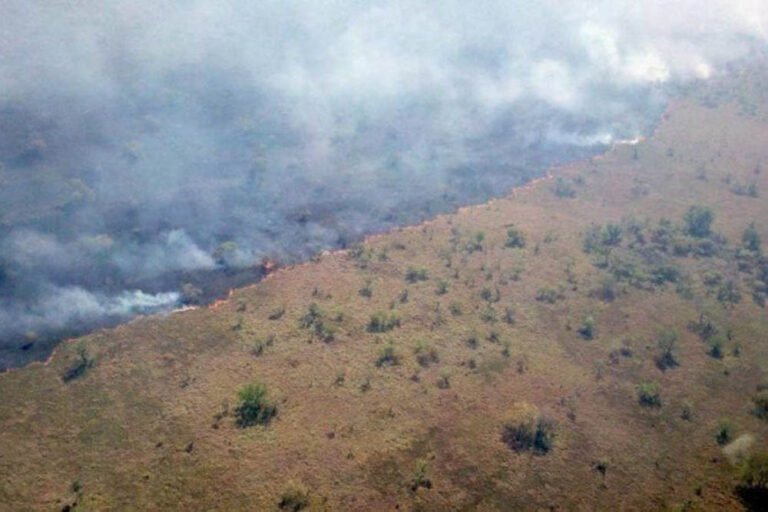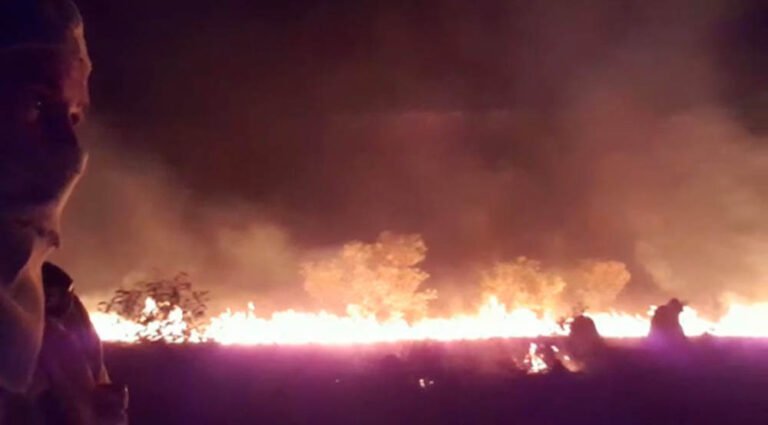The island is one of the most important conservation areas in Brazil, part of which is demarcated as a National Park and the rest as three separate indigenous lands. One is the Utaria Wyhyna/Iròdu Iràna Indigenous Land, which has a declaratory decree and awaits ratification, and the other two, the Inawebohona and Parque do Araguaia Indigenous Lands, have been demarcated and ratified, with a population of approximately 3,500 members of the Javaé and Karajá indigenous peoples, and 42 Avá-Canoeiro indigenous people.
In addition to those peoples, some of the Avá-Canoeiro indigenous people live in voluntary isolation. Their presence was confirmed during a helicopter flight by a fire brigade worker who was fighting a forest fire in the region on October 9, 2019. He reported seeing eight indigenous people of an unidentified ethnicity, six adults and two children.[1] The Mata do Mamão is known as the last refuge of this group of indigenous people in voluntary isolation and was also the area most severely affected by the fires in 2020.
The area includes the southern region of the Inawebohona Indigenous Land and the entire Parque do Araguaia Indigenous Land. In order to safeguard the lives and the physical and cultural integrity of the people there, a Federal Court, at the request of the Federal Public Prosecutor’s Office (MPF) through a Civil Class Action Lawsuit, ordered that the entry and transit of outsiders to Mata do Mamão be restricted, and that the National Indian Foundation (Funai) and the Chico Mendes Institute for Biodiversity Conservation (ICMBio) take measures to locate and verify records of the existence of the Avá-Canoeiro in the Mata do Mamão, identify major threats to the group, and prepare a Monitoring Plan with measures to protect the isolated people.[2]
Notas
Report by firefighter Sidey /audios via WhatsApp: Pegadas que seriam de indígenas isolados são encontradas na Ilha do Bananal. G1 Tocantins, October 23, 2019.
There are several threats to the indigenous territory and the environmental preservation area of the Araguaia National Park. One is the drying up of the Formoso and Javaé rivers, due, above all, to commercial irrigated rice plantations in the region neighboring the island.[3] Another threat is the presence of cattle ranchers in the area, who threaten the physical and cultural integrity of the people by leasing pastureland and building “retreats”[4] for non-indigenous cowboys.
Notas
Giant pumps taking water from the Formoso River Basin, in 2020, in Tocantins. Credit: MPTO.
According to the Tocantins State Agricultural Defense Agency (ADAPEC), Bananal Island has about 100,000 head of cattle, with 344 “retreats”.[5] The fires inside the island intensify every year during the dry season, from August to November, the period when leaseholders in the region renew their pastures with fires. Not only is fire management in the dry season not recommended due to the risk of wildfires, the practice of leasing land inside indigenous territory is illegal, according to the 1988 Federal Constitution[6], which provides that: “The lands traditionally occupied by Indians are intended for their permanent possession and they shall have the exclusive usufruct of the riches of the soil, the rivers and the lakes existing therein. … The lands referred to in this article are inalienable and indisposable and the rights thereto are not subject to limitation.”
This conflict and invasion of the Bananal Island by cattle ranchers has been going on since 1960, when ranches were first established on the banks of the Javaé and Formoso rivers. In the following decades, especially in the 1980s and 1990s, the number of non-indigenous residents grew rapidly on the island. As a result, in the late 1990s a group of Javaé leaders requested that the MPF order the removal of the cattle and the families who were inside the indigenous territory. Even after the removal of the invaders, the practice of leasing pastureland continues inside the indigenous territory.[7] Through an out-of-court settlement (TAC) mediated by federal prosecutors (MPF) in Tocantins, a 2009[8] agreement with Funai allows the presence of cattle from large ranches inside the land, under the control of the Javaé. The Javaé leaders founded an organization – the Council of Javaé Indigenous Organizations of Bananal Island (Conjaba) and the Barreira Branca Association – to negotiate leases with ranchers for these pastures. The Conjaba association took over negotiations for the entry of cattle. As a result, tensions within the territory intensified, especially over the presence of non-indigenous people and environmental damage, as well as the distribution of earnings among the villages.
Moreover, the risk of losing control is always imminent, with serious consequences for the environment and for people living in and around the island. As a result, huge fires break out every year in the Mata do Mamão.
Notas
Dinalva Martins. Governo do Tocantins deve vacinar 100 mil bovinos contra febre aftosa na Ilha do Bananal. Governo do Tocantins, July 10, 2020.
Constitution of the Federative Republic of Brazil, Chapter VIII – INDIANS (ARTS. 231 and 232)
Patrícia de Mendonça Rodrigues. A invasão e a desocupação da Ilha do Bananal. In: Instituto Socioambiental (ISA). Povos Indígenas no Brasil.
From January to October 2020, the Araguaia Park Indigenous Land had 8,792 fire outbreaks, according to NASA’s active fire data, accessed through the Global Forest Watch platform, making it the second most heavily affected Indigenous Land in the country that year.[9] The other Indigenous Lands on the island were also very affected by fires, especially during the typically driest months of the year.
Notas
Repórter Brasil, November 2020. Abandonadas pela Funai, 60% das terras indígenas são devastadas por mais de 100 mil focos de incêndio.

Eliane Franco Martins works with the Missionary Council for Indigenous Peoples (Conselho Indigenista Missionário/CIMI), Goiás/Tocantins Region






